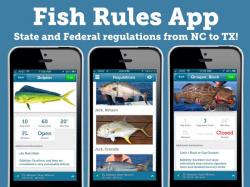Federal Fishing Regulations Moving To New Fish Rules Mobile App
December 18, 2017 | 2 min to read

North Charleston, SC – Keeping up with offshore fishing regulations can be a challenge. Many fishermen have taken advantage of the South Atlantic Fishery Management Council-sponsored South Atlantic Fishing Regulations mobile application over the past few years. The free app has provided regulation information for both recreational and commercial fishermen fishing in federal waters (ranging from 3 to 200 nautical miles) off the South Atlantic Coast.
As of January 1, 2018, the Council will begin using the Fish Rules mobile app to keep fishermen updated on federal fishing regulations in the South Atlantic. Fish Rules offers a platform for new features, is user friendly, and has a fast-growing user base along the entire East coast. It also hosts state fishing regulations for those anglers fishing in state waters. For now, the Fish Rules mobile app provides regulation information for recreational regulations. Work is underway with the app developers to also provide commercial regulations in the future.
In order to keep stakeholders accurately informed during the transition, users of the current SA Fishing Regulations mobile app are asked to begin moving to Fish Rules. Both mobile applications will be updated until January 1, 2018, when regulation information will transition completely to Fish Rules.
Information on the mobile regulations application is available from the Council’s website at: http://safmc.net/regulations/transition-to-fish-rules-mobile-app/. Please contact Outreach Specialist Cameron Rhodes at cameron.rhodes@safmc.net or call 843/571-4366 with specific questions. Both commercial and recreational federal regulations for species managed by the Council are available from the Council's website at:http://safmc.net/regulations/.
About the South Atlantic Fishery Management Council
The South Atlantic Fishery Management Council, one of eight regional councils, conserves and manages fish stocks from three to 200 miles offshore of North Carolina, South Carolina, Georgia and east Florida. For more information, visit:
Source: South Atlantic Fishery Management Council
